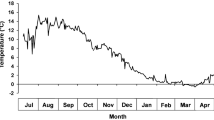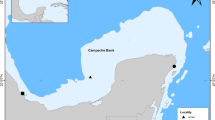Abstract
At Discovery Bay, Jamaica, Tripneustes ventricosus lives in beds of the turtle grass Thalassia testudinum. Especially during daylight hours, it covers its aboral surface with fragments of this plant and other objects. Normally pigmented, wild-type sea urchins covered themselves significantly less with Thalassia when sunlight was experimentally decreased to 66% or 32% ambient intensity. Consistent with this result, naturally occurring sea urchins exhibited significantly less covering at a deep (3.5 m) site than at a shallow (1 m) site, where light intensities at the bottom were 619 and 946 μmol s−1 m−2, respectively. The graded covering response to light intensity suggests that covering is a defense against damaging solar radiation. Albino sea urchins covered themselves significantly more with Thalassia than wild-type sea urchins in both full and 66% sunlight. In addition, at the shallow site where they accounted for about 4% of the population, they showed significantly greater covering than wild-type urchins. The greater covering response of albino sea urchins suggests a greater susceptibility to solar radiation.




Similar content being viewed by others
References
Adams NL (2001) UV radiation evokes negative phototaxis and covering behavior in the sea urchin Strongylocentrotus droebachiensis. Mar Ecol Prog Ser 213:87–95
Agatsuma Y (2001) Effect of the covering behavior of the juvenile sea urchin Strongylocentrotus intermedius on predation by the spider crab Pugettia quadridens. Fish Sci 67:1181–1183
Amsler CD, McClintock JB, Baker BJ (1999) An Antarctic feeding triangle: defensive interactions between macroalgae, sea urchins, and sea anemones. Mar Ecol Prog Ser 183:105–114
Barnes DKA, Crook AC (2001) Quantifying behavioural determinants of the coastal European sea-urchin Paracentrotus lividus. Mar Biol 138:1205–1212
Crook AC (2003) Individual variation in the covering behaviour of the shallow water sea urchin Paracentrotus lividus. Pubbl Stn Zool Napoli Mar Ecol 24:275–287
Crook AC, Barnes DKA (2001) Seasonal variation in the covering behaviour of the echinoid Paracentrotus lividus (Lamarck). Pubbl Stn Zool Napoli Mar Ecol 22:231–239
Dix TG (1970) Covering response of the echinoid Evechinus chloroticus (Val.). Pac Sci 24:187–194
Douglas CA (1976) Availability of drift materials and the covering response of the sea urchin Strongylocentrotus purpuratus (Stimpson). Pac Sci 30:83–89
James DW (2000) Diet, movement, and covering behavior of the sea urchin Toxopneustes roseus in rhodolith beds in the Gulf of California, Mexico. Mar Biol 137:913–923
Lees DC, Carter GA (1972) The covering response to surge, sunlight and ultraviolet light in Lytechinus anamesus (Echinoidea) Ecology 53:1127–1133
Lewis JB (1958) The biology of the tropical sea urchin Tripneustes esculentus Leske in Barbados, British West Indies. Can J Zool 36:607–621
Millott N (1956) The covering reaction of sea-urchins I. A preliminary account of covering in the tropical echinoid Lytechinus variegatus (Lamarck), and its relation to light. J Exp Biol 3:508–523
Millott N (1975) The photosensitivity of echinoids. Adv Mar Biol 13:1–52
Richner H, Milinski M (2000) On the functional significance of masking behaviour in sea urchins—an experiment with Paracentrotus lividus. Mar Ecol Prog Ser 205:307–308
Sharp DT, Gray IE (1962) Studies on factors affecting the local distribution of two sea urchins, Arbacia punctulata and Lytechinus variegatus. Ecology 43:309–313
Tertschnig WP (1989) Diel activity patterns and foraging dynamics of the sea urchin Tripneustes ventricosus in a tropical seagrass community and a reef environment (Virgin Islands). Mar Ecol 10:3–21
Verling, E, Crook AC, Barnes DKA (2002) Covering behaviour in Paracentrotus lividus: is light important? Mar Biol 140:391–396
Zar JH (1999) Biostatistical analysis. Prentice Hall, Upper Saddle River, N.J.
Acknowledgements
This study was conducted at the Discovery Bay Marine Laboratory (DBML), Jamaica, in the winter of 2003 as part of Dartmouth College’s Foreign Study Program in Tropical Ecology. We thank the DBML staff for facilities and hospitality, the East/West Marine Biology Program for use of their light meter, and Megan Donahue and three anonymous referees for comments that improved the manuscript. Unpublished experiments mentioned in the text were conducted in previous winters by L.C. Broughton, J.L. Butcher, D.M. Larson, K.S. Nowak, L.V. Reynolds, and D.K. Schreiber. This is publication number 692 of the DBML.
Author information
Authors and Affiliations
Corresponding author
Additional information
Communicated by P. W. Sammarco, Chauvin
Rights and permissions
About this article
Cite this article
Kehas, A.J., Theoharides, K.A. & Gilbert, J.J. Effect of sunlight intensity and albinism on the covering response of the Caribbean sea urchin Tripneustes ventricosus. Marine Biology 146, 1111–1117 (2005). https://doi.org/10.1007/s00227-004-1514-4
Received:
Accepted:
Published:
Issue Date:
DOI: https://doi.org/10.1007/s00227-004-1514-4




